American and Southern Gothic: Vampires in Literature Analysis
VerifiedAdded on 2020/06/06
|8
|2580
|113
Essay
AI Summary
This essay delves into the multifaceted world of vampire mythology, tracing its evolution from folklore to its prominent presence in literature, particularly within the American and Southern Gothic traditions. The essay begins by examining the historical roots and cultural significance of vampire myths, exploring how these creatures have been depicted across various cultures and time periods. It then analyzes the key characteristics and literary representations of vampires, including their association with the undead, blood-sucking, and supernatural abilities. Furthermore, the essay investigates the themes and motifs central to American and Southern Gothic literature, such as the interplay of rational and irrational elements, the influence of Puritanism, and the exploration of societal anxieties. Through a comparative analysis of literary works, the essay highlights the distinct ways in which vampires are portrayed in these Gothic subgenres, reflecting broader cultural and historical contexts. Overall, the essay provides a comprehensive overview of vampire mythology and its enduring impact on literature.

Essay
Paraphrase This Document
Need a fresh take? Get an instant paraphrase of this document with our AI Paraphraser

Table of Contents
Assessment 1 : “ Introducing the Vampire”....................................................................................1
Assessment 2 : American and Southern Gothic .............................................................................3
REFERENCES ...............................................................................................................................6
Assessment 1 : “ Introducing the Vampire”....................................................................................1
Assessment 2 : American and Southern Gothic .............................................................................3
REFERENCES ...............................................................................................................................6
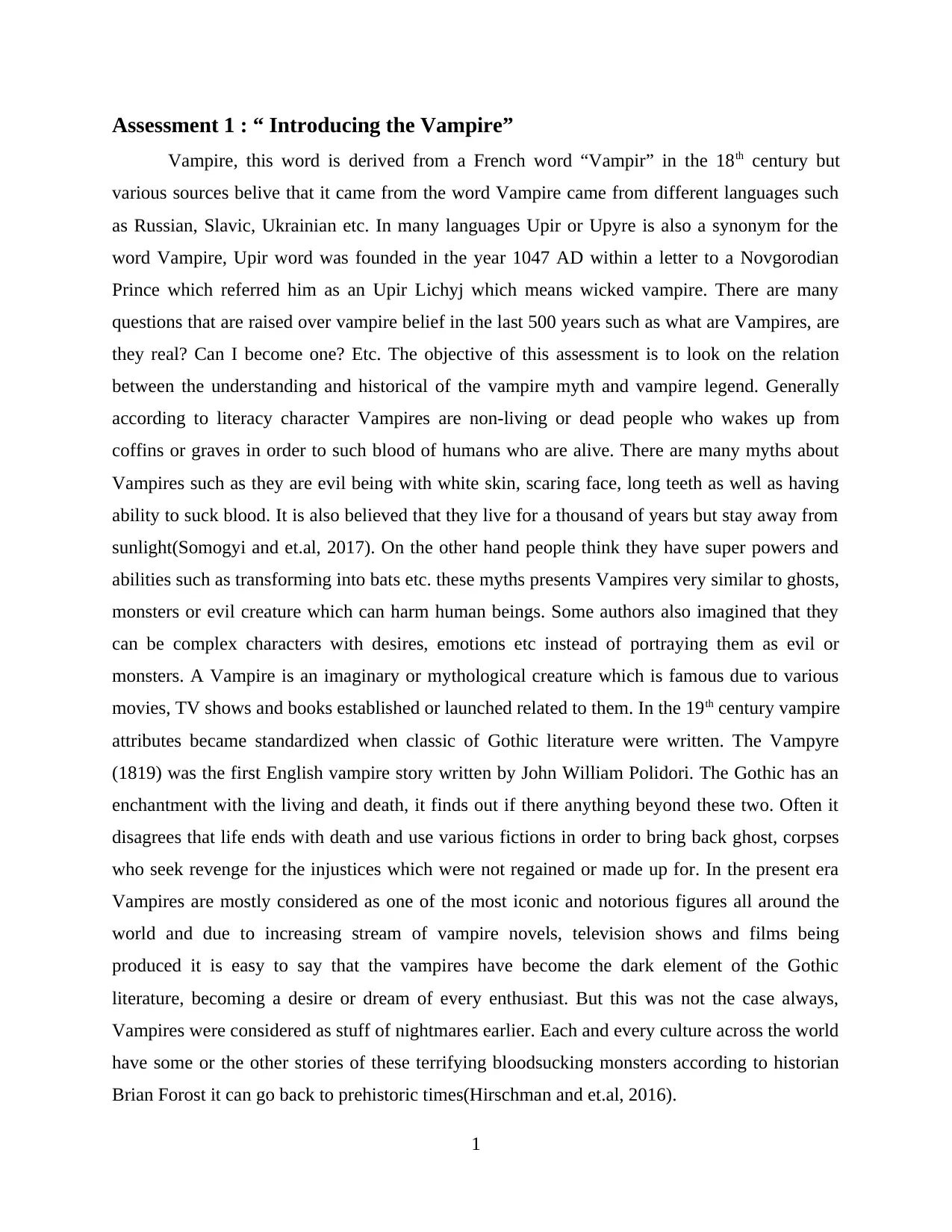
Assessment 1 : “ Introducing the Vampire”
Vampire, this word is derived from a French word “Vampir” in the 18th century but
various sources belive that it came from the word Vampire came from different languages such
as Russian, Slavic, Ukrainian etc. In many languages Upir or Upyre is also a synonym for the
word Vampire, Upir word was founded in the year 1047 AD within a letter to a Novgorodian
Prince which referred him as an Upir Lichyj which means wicked vampire. There are many
questions that are raised over vampire belief in the last 500 years such as what are Vampires, are
they real? Can I become one? Etc. The objective of this assessment is to look on the relation
between the understanding and historical of the vampire myth and vampire legend. Generally
according to literacy character Vampires are non-living or dead people who wakes up from
coffins or graves in order to such blood of humans who are alive. There are many myths about
Vampires such as they are evil being with white skin, scaring face, long teeth as well as having
ability to suck blood. It is also believed that they live for a thousand of years but stay away from
sunlight(Somogyi and et.al, 2017). On the other hand people think they have super powers and
abilities such as transforming into bats etc. these myths presents Vampires very similar to ghosts,
monsters or evil creature which can harm human beings. Some authors also imagined that they
can be complex characters with desires, emotions etc instead of portraying them as evil or
monsters. A Vampire is an imaginary or mythological creature which is famous due to various
movies, TV shows and books established or launched related to them. In the 19th century vampire
attributes became standardized when classic of Gothic literature were written. The Vampyre
(1819) was the first English vampire story written by John William Polidori. The Gothic has an
enchantment with the living and death, it finds out if there anything beyond these two. Often it
disagrees that life ends with death and use various fictions in order to bring back ghost, corpses
who seek revenge for the injustices which were not regained or made up for. In the present era
Vampires are mostly considered as one of the most iconic and notorious figures all around the
world and due to increasing stream of vampire novels, television shows and films being
produced it is easy to say that the vampires have become the dark element of the Gothic
literature, becoming a desire or dream of every enthusiast. But this was not the case always,
Vampires were considered as stuff of nightmares earlier. Each and every culture across the world
have some or the other stories of these terrifying bloodsucking monsters according to historian
Brian Forost it can go back to prehistoric times(Hirschman and et.al, 2016).
1
Vampire, this word is derived from a French word “Vampir” in the 18th century but
various sources belive that it came from the word Vampire came from different languages such
as Russian, Slavic, Ukrainian etc. In many languages Upir or Upyre is also a synonym for the
word Vampire, Upir word was founded in the year 1047 AD within a letter to a Novgorodian
Prince which referred him as an Upir Lichyj which means wicked vampire. There are many
questions that are raised over vampire belief in the last 500 years such as what are Vampires, are
they real? Can I become one? Etc. The objective of this assessment is to look on the relation
between the understanding and historical of the vampire myth and vampire legend. Generally
according to literacy character Vampires are non-living or dead people who wakes up from
coffins or graves in order to such blood of humans who are alive. There are many myths about
Vampires such as they are evil being with white skin, scaring face, long teeth as well as having
ability to suck blood. It is also believed that they live for a thousand of years but stay away from
sunlight(Somogyi and et.al, 2017). On the other hand people think they have super powers and
abilities such as transforming into bats etc. these myths presents Vampires very similar to ghosts,
monsters or evil creature which can harm human beings. Some authors also imagined that they
can be complex characters with desires, emotions etc instead of portraying them as evil or
monsters. A Vampire is an imaginary or mythological creature which is famous due to various
movies, TV shows and books established or launched related to them. In the 19th century vampire
attributes became standardized when classic of Gothic literature were written. The Vampyre
(1819) was the first English vampire story written by John William Polidori. The Gothic has an
enchantment with the living and death, it finds out if there anything beyond these two. Often it
disagrees that life ends with death and use various fictions in order to bring back ghost, corpses
who seek revenge for the injustices which were not regained or made up for. In the present era
Vampires are mostly considered as one of the most iconic and notorious figures all around the
world and due to increasing stream of vampire novels, television shows and films being
produced it is easy to say that the vampires have become the dark element of the Gothic
literature, becoming a desire or dream of every enthusiast. But this was not the case always,
Vampires were considered as stuff of nightmares earlier. Each and every culture across the world
have some or the other stories of these terrifying bloodsucking monsters according to historian
Brian Forost it can go back to prehistoric times(Hirschman and et.al, 2016).
1
⊘ This is a preview!⊘
Do you want full access?
Subscribe today to unlock all pages.

Trusted by 1+ million students worldwide
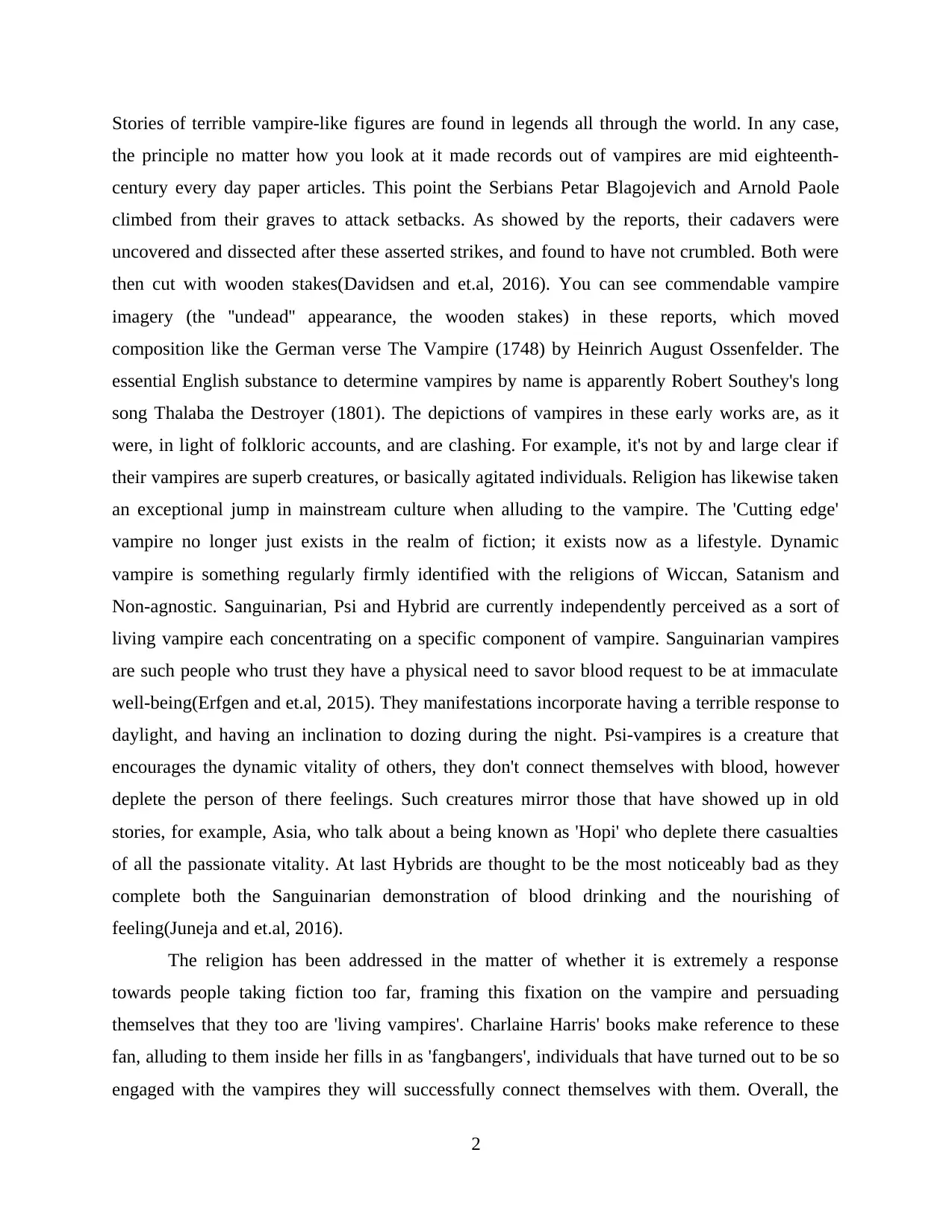
Stories of terrible vampire-like figures are found in legends all through the world. In any case,
the principle no matter how you look at it made records out of vampires are mid eighteenth-
century every day paper articles. This point the Serbians Petar Blagojevich and Arnold Paole
climbed from their graves to attack setbacks. As showed by the reports, their cadavers were
uncovered and dissected after these asserted strikes, and found to have not crumbled. Both were
then cut with wooden stakes(Davidsen and et.al, 2016). You can see commendable vampire
imagery (the ''undead'' appearance, the wooden stakes) in these reports, which moved
composition like the German verse The Vampire (1748) by Heinrich August Ossenfelder. The
essential English substance to determine vampires by name is apparently Robert Southey's long
song Thalaba the Destroyer (1801). The depictions of vampires in these early works are, as it
were, in light of folkloric accounts, and are clashing. For example, it's not by and large clear if
their vampires are superb creatures, or basically agitated individuals. Religion has likewise taken
an exceptional jump in mainstream culture when alluding to the vampire. The 'Cutting edge'
vampire no longer just exists in the realm of fiction; it exists now as a lifestyle. Dynamic
vampire is something regularly firmly identified with the religions of Wiccan, Satanism and
Non-agnostic. Sanguinarian, Psi and Hybrid are currently independently perceived as a sort of
living vampire each concentrating on a specific component of vampire. Sanguinarian vampires
are such people who trust they have a physical need to savor blood request to be at immaculate
well-being(Erfgen and et.al, 2015). They manifestations incorporate having a terrible response to
daylight, and having an inclination to dozing during the night. Psi-vampires is a creature that
encourages the dynamic vitality of others, they don't connect themselves with blood, however
deplete the person of there feelings. Such creatures mirror those that have showed up in old
stories, for example, Asia, who talk about a being known as 'Hopi' who deplete there casualties
of all the passionate vitality. At last Hybrids are thought to be the most noticeably bad as they
complete both the Sanguinarian demonstration of blood drinking and the nourishing of
feeling(Juneja and et.al, 2016).
The religion has been addressed in the matter of whether it is extremely a response
towards people taking fiction too far, framing this fixation on the vampire and persuading
themselves that they too are 'living vampires'. Charlaine Harris' books make reference to these
fan, alluding to them inside her fills in as 'fangbangers', individuals that have turned out to be so
engaged with the vampires they will successfully connect themselves with them. Overall, the
2
the principle no matter how you look at it made records out of vampires are mid eighteenth-
century every day paper articles. This point the Serbians Petar Blagojevich and Arnold Paole
climbed from their graves to attack setbacks. As showed by the reports, their cadavers were
uncovered and dissected after these asserted strikes, and found to have not crumbled. Both were
then cut with wooden stakes(Davidsen and et.al, 2016). You can see commendable vampire
imagery (the ''undead'' appearance, the wooden stakes) in these reports, which moved
composition like the German verse The Vampire (1748) by Heinrich August Ossenfelder. The
essential English substance to determine vampires by name is apparently Robert Southey's long
song Thalaba the Destroyer (1801). The depictions of vampires in these early works are, as it
were, in light of folkloric accounts, and are clashing. For example, it's not by and large clear if
their vampires are superb creatures, or basically agitated individuals. Religion has likewise taken
an exceptional jump in mainstream culture when alluding to the vampire. The 'Cutting edge'
vampire no longer just exists in the realm of fiction; it exists now as a lifestyle. Dynamic
vampire is something regularly firmly identified with the religions of Wiccan, Satanism and
Non-agnostic. Sanguinarian, Psi and Hybrid are currently independently perceived as a sort of
living vampire each concentrating on a specific component of vampire. Sanguinarian vampires
are such people who trust they have a physical need to savor blood request to be at immaculate
well-being(Erfgen and et.al, 2015). They manifestations incorporate having a terrible response to
daylight, and having an inclination to dozing during the night. Psi-vampires is a creature that
encourages the dynamic vitality of others, they don't connect themselves with blood, however
deplete the person of there feelings. Such creatures mirror those that have showed up in old
stories, for example, Asia, who talk about a being known as 'Hopi' who deplete there casualties
of all the passionate vitality. At last Hybrids are thought to be the most noticeably bad as they
complete both the Sanguinarian demonstration of blood drinking and the nourishing of
feeling(Juneja and et.al, 2016).
The religion has been addressed in the matter of whether it is extremely a response
towards people taking fiction too far, framing this fixation on the vampire and persuading
themselves that they too are 'living vampires'. Charlaine Harris' books make reference to these
fan, alluding to them inside her fills in as 'fangbangers', individuals that have turned out to be so
engaged with the vampires they will successfully connect themselves with them. Overall, the
2
Paraphrase This Document
Need a fresh take? Get an instant paraphrase of this document with our AI Paraphraser
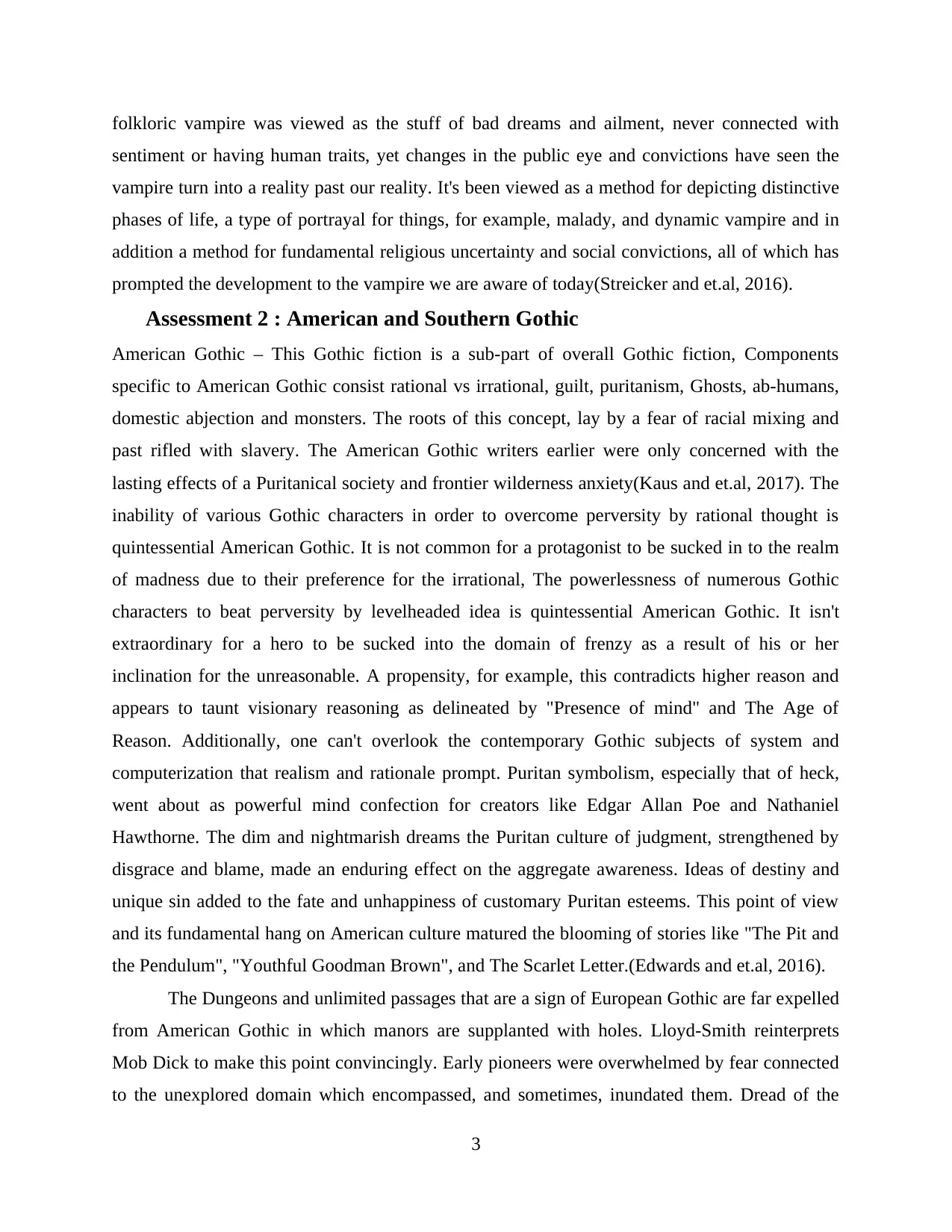
folkloric vampire was viewed as the stuff of bad dreams and ailment, never connected with
sentiment or having human traits, yet changes in the public eye and convictions have seen the
vampire turn into a reality past our reality. It's been viewed as a method for depicting distinctive
phases of life, a type of portrayal for things, for example, malady, and dynamic vampire and in
addition a method for fundamental religious uncertainty and social convictions, all of which has
prompted the development to the vampire we are aware of today(Streicker and et.al, 2016).
Assessment 2 : American and Southern Gothic
American Gothic – This Gothic fiction is a sub-part of overall Gothic fiction, Components
specific to American Gothic consist rational vs irrational, guilt, puritanism, Ghosts, ab-humans,
domestic abjection and monsters. The roots of this concept, lay by a fear of racial mixing and
past rifled with slavery. The American Gothic writers earlier were only concerned with the
lasting effects of a Puritanical society and frontier wilderness anxiety(Kaus and et.al, 2017). The
inability of various Gothic characters in order to overcome perversity by rational thought is
quintessential American Gothic. It is not common for a protagonist to be sucked in to the realm
of madness due to their preference for the irrational, The powerlessness of numerous Gothic
characters to beat perversity by levelheaded idea is quintessential American Gothic. It isn't
extraordinary for a hero to be sucked into the domain of frenzy as a result of his or her
inclination for the unreasonable. A propensity, for example, this contradicts higher reason and
appears to taunt visionary reasoning as delineated by "Presence of mind" and The Age of
Reason. Additionally, one can't overlook the contemporary Gothic subjects of system and
computerization that realism and rationale prompt. Puritan symbolism, especially that of heck,
went about as powerful mind confection for creators like Edgar Allan Poe and Nathaniel
Hawthorne. The dim and nightmarish dreams the Puritan culture of judgment, strengthened by
disgrace and blame, made an enduring effect on the aggregate awareness. Ideas of destiny and
unique sin added to the fate and unhappiness of customary Puritan esteems. This point of view
and its fundamental hang on American culture matured the blooming of stories like "The Pit and
the Pendulum", "Youthful Goodman Brown", and The Scarlet Letter.(Edwards and et.al, 2016).
The Dungeons and unlimited passages that are a sign of European Gothic are far expelled
from American Gothic in which manors are supplanted with holes. Lloyd-Smith reinterprets
Mob Dick to make this point convincingly. Early pioneers were overwhelmed by fear connected
to the unexplored domain which encompassed, and sometimes, inundated them. Dread of the
3
sentiment or having human traits, yet changes in the public eye and convictions have seen the
vampire turn into a reality past our reality. It's been viewed as a method for depicting distinctive
phases of life, a type of portrayal for things, for example, malady, and dynamic vampire and in
addition a method for fundamental religious uncertainty and social convictions, all of which has
prompted the development to the vampire we are aware of today(Streicker and et.al, 2016).
Assessment 2 : American and Southern Gothic
American Gothic – This Gothic fiction is a sub-part of overall Gothic fiction, Components
specific to American Gothic consist rational vs irrational, guilt, puritanism, Ghosts, ab-humans,
domestic abjection and monsters. The roots of this concept, lay by a fear of racial mixing and
past rifled with slavery. The American Gothic writers earlier were only concerned with the
lasting effects of a Puritanical society and frontier wilderness anxiety(Kaus and et.al, 2017). The
inability of various Gothic characters in order to overcome perversity by rational thought is
quintessential American Gothic. It is not common for a protagonist to be sucked in to the realm
of madness due to their preference for the irrational, The powerlessness of numerous Gothic
characters to beat perversity by levelheaded idea is quintessential American Gothic. It isn't
extraordinary for a hero to be sucked into the domain of frenzy as a result of his or her
inclination for the unreasonable. A propensity, for example, this contradicts higher reason and
appears to taunt visionary reasoning as delineated by "Presence of mind" and The Age of
Reason. Additionally, one can't overlook the contemporary Gothic subjects of system and
computerization that realism and rationale prompt. Puritan symbolism, especially that of heck,
went about as powerful mind confection for creators like Edgar Allan Poe and Nathaniel
Hawthorne. The dim and nightmarish dreams the Puritan culture of judgment, strengthened by
disgrace and blame, made an enduring effect on the aggregate awareness. Ideas of destiny and
unique sin added to the fate and unhappiness of customary Puritan esteems. This point of view
and its fundamental hang on American culture matured the blooming of stories like "The Pit and
the Pendulum", "Youthful Goodman Brown", and The Scarlet Letter.(Edwards and et.al, 2016).
The Dungeons and unlimited passages that are a sign of European Gothic are far expelled
from American Gothic in which manors are supplanted with holes. Lloyd-Smith reinterprets
Mob Dick to make this point convincingly. Early pioneers were overwhelmed by fear connected
to the unexplored domain which encompassed, and sometimes, inundated them. Dread of the
3

obscure originating from natural variables like haziness and unfathomability is outstanding in
Charles Brockden Brown's Edgar Huntly.
The rise of the "stomach muscle human" in American gothic fiction was firmly combined with
Darwinism. Ideas of development or devolution of an animal category; new natural information
and innovative headway made a ripe situation for some to scrutinize their fundamental
humankind. Parallels among people and each other living thing on the planet were made clear by
the previously mentioned. This is show in stories like H.P. Lovecraft's "The Outsider" and
Nicholson Baker's "Subsoil". Apparitions and beasts are firmly identified with this topic, they
work as what might as well be called the ab-human and might be reminiscent of inconspicuous
substances, as in The Bostonian. There is a difficult sort of American darkness, and it is one
suffused with light. Awe inspiring sunlight covers a whited-out clever, smiling faces conceal the
greatness of inconvenience. It isn't the same as the murkiness, the Gothicism of Europe.
Mediterranean lack of clarity is Caravaggesque, reduce detainment facilities and hot blood and
skyward-looking holy people: The Romantic Gothicism of Matthew Lewis' The Monk and Ann
Radcliffe's The Italian. English lack of clarity is associated with the fumes billow of
industrialized urban groups, Conan Doyle and Jack the Ripper. Scandinavian dimness is besides
more strict, not hid a long way from light by annihilated fortresses and ardent isolate regions, yet
in view of the nonappearance of satisfactory sun, days exhausted pale, cotton sky, months
without wonder. Regardless, American Gothicism is duskiness despite the sun. Moreover, the
brighter it is, the all the additionally vexing(Street and et.al, 2016).
Southern Gothic does not pester strain and the effective. Or on the other hand perhaps, there is
diminished cunning in the stories. It takes in the wake of revealing the issues of society, however
does accordingly by making complex characters. The makers examined the acts of people
(regularly unusual) and the social demand of the South. Through their stories, the makers would
have gotten a kick out of the chance to exhibit that the social demand was sensitive, and the
substances behind it were extremely disturbing. The makers work to raise assurances of Southern
culture and its moral shortcomings. The subjects of this grouping are created around these
destinations. The stories of Southern Gothic are, clearly, set in the South. They may occur on an
estate, old slave quarters or isolated towns(Perez and et.al, 2015). There are various Southern
segments in the stories, including tongue, affinities and personalities. The chronicled scenery of
the South is addressed through the settings of the stories. The characters are generally personality
4
Charles Brockden Brown's Edgar Huntly.
The rise of the "stomach muscle human" in American gothic fiction was firmly combined with
Darwinism. Ideas of development or devolution of an animal category; new natural information
and innovative headway made a ripe situation for some to scrutinize their fundamental
humankind. Parallels among people and each other living thing on the planet were made clear by
the previously mentioned. This is show in stories like H.P. Lovecraft's "The Outsider" and
Nicholson Baker's "Subsoil". Apparitions and beasts are firmly identified with this topic, they
work as what might as well be called the ab-human and might be reminiscent of inconspicuous
substances, as in The Bostonian. There is a difficult sort of American darkness, and it is one
suffused with light. Awe inspiring sunlight covers a whited-out clever, smiling faces conceal the
greatness of inconvenience. It isn't the same as the murkiness, the Gothicism of Europe.
Mediterranean lack of clarity is Caravaggesque, reduce detainment facilities and hot blood and
skyward-looking holy people: The Romantic Gothicism of Matthew Lewis' The Monk and Ann
Radcliffe's The Italian. English lack of clarity is associated with the fumes billow of
industrialized urban groups, Conan Doyle and Jack the Ripper. Scandinavian dimness is besides
more strict, not hid a long way from light by annihilated fortresses and ardent isolate regions, yet
in view of the nonappearance of satisfactory sun, days exhausted pale, cotton sky, months
without wonder. Regardless, American Gothicism is duskiness despite the sun. Moreover, the
brighter it is, the all the additionally vexing(Street and et.al, 2016).
Southern Gothic does not pester strain and the effective. Or on the other hand perhaps, there is
diminished cunning in the stories. It takes in the wake of revealing the issues of society, however
does accordingly by making complex characters. The makers examined the acts of people
(regularly unusual) and the social demand of the South. Through their stories, the makers would
have gotten a kick out of the chance to exhibit that the social demand was sensitive, and the
substances behind it were extremely disturbing. The makers work to raise assurances of Southern
culture and its moral shortcomings. The subjects of this grouping are created around these
destinations. The stories of Southern Gothic are, clearly, set in the South. They may occur on an
estate, old slave quarters or isolated towns(Perez and et.al, 2015). There are various Southern
segments in the stories, including tongue, affinities and personalities. The chronicled scenery of
the South is addressed through the settings of the stories. The characters are generally personality
4
⊘ This is a preview!⊘
Do you want full access?
Subscribe today to unlock all pages.

Trusted by 1+ million students worldwide
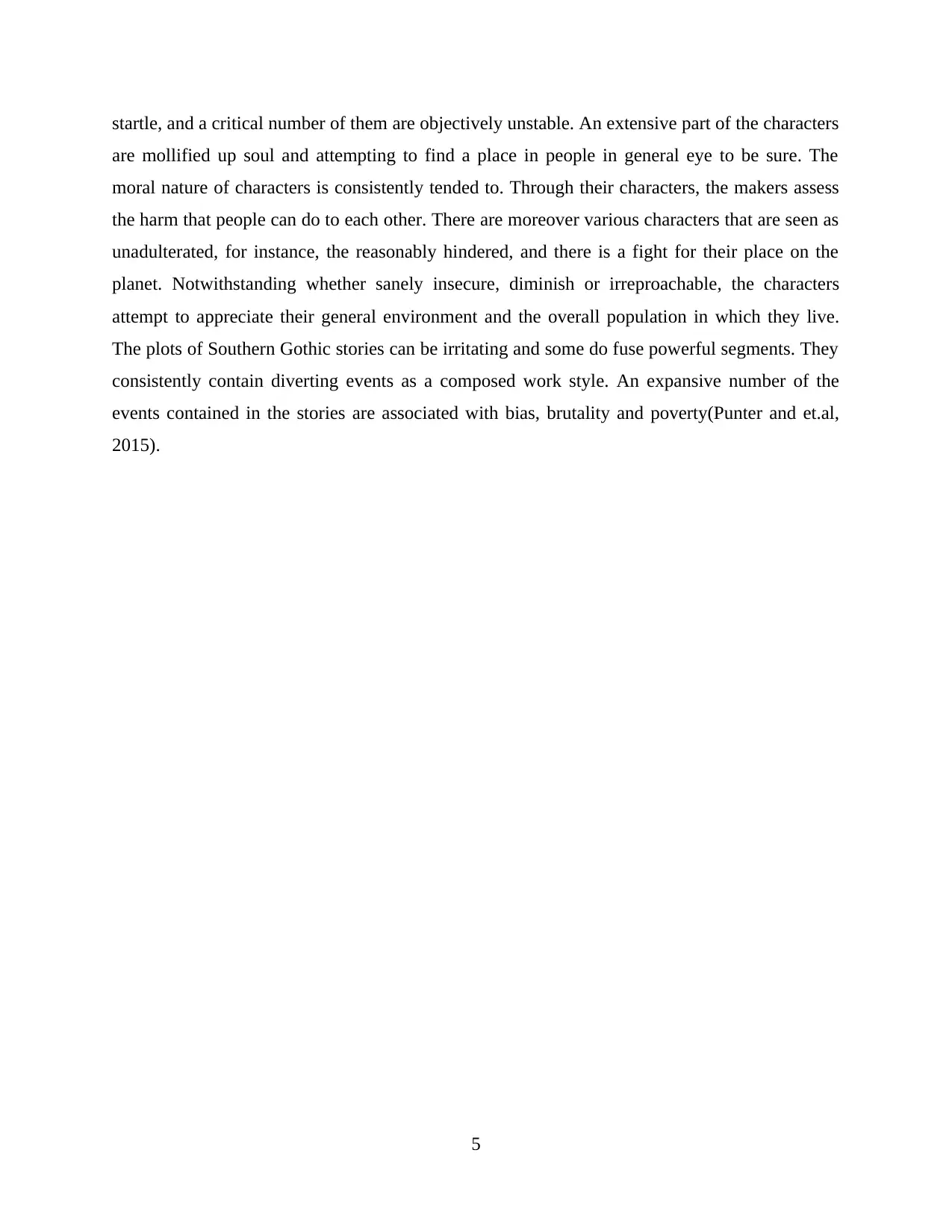
startle, and a critical number of them are objectively unstable. An extensive part of the characters
are mollified up soul and attempting to find a place in people in general eye to be sure. The
moral nature of characters is consistently tended to. Through their characters, the makers assess
the harm that people can do to each other. There are moreover various characters that are seen as
unadulterated, for instance, the reasonably hindered, and there is a fight for their place on the
planet. Notwithstanding whether sanely insecure, diminish or irreproachable, the characters
attempt to appreciate their general environment and the overall population in which they live.
The plots of Southern Gothic stories can be irritating and some do fuse powerful segments. They
consistently contain diverting events as a composed work style. An expansive number of the
events contained in the stories are associated with bias, brutality and poverty(Punter and et.al,
2015).
5
are mollified up soul and attempting to find a place in people in general eye to be sure. The
moral nature of characters is consistently tended to. Through their characters, the makers assess
the harm that people can do to each other. There are moreover various characters that are seen as
unadulterated, for instance, the reasonably hindered, and there is a fight for their place on the
planet. Notwithstanding whether sanely insecure, diminish or irreproachable, the characters
attempt to appreciate their general environment and the overall population in which they live.
The plots of Southern Gothic stories can be irritating and some do fuse powerful segments. They
consistently contain diverting events as a composed work style. An expansive number of the
events contained in the stories are associated with bias, brutality and poverty(Punter and et.al,
2015).
5
Paraphrase This Document
Need a fresh take? Get an instant paraphrase of this document with our AI Paraphraser
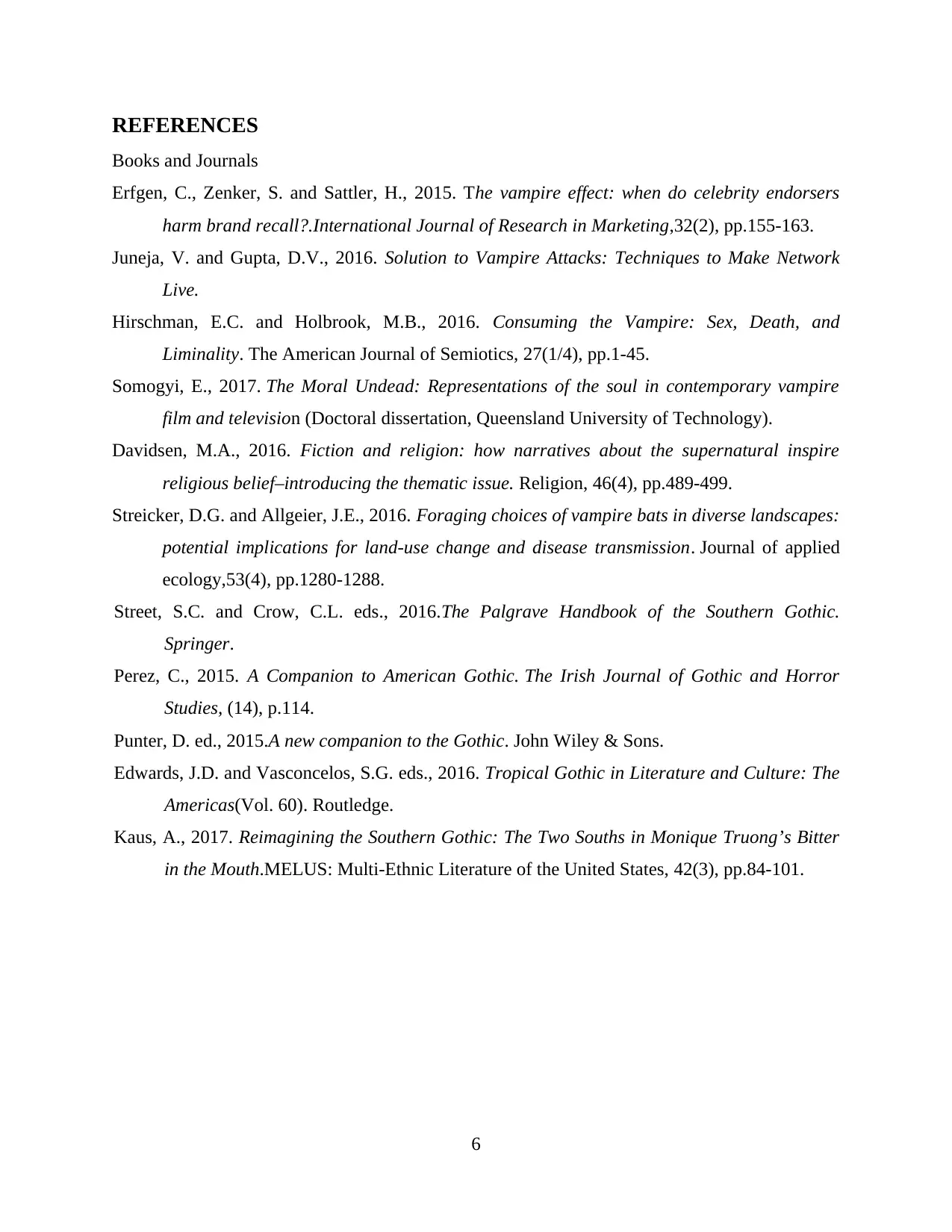
REFERENCES
Books and Journals
Erfgen, C., Zenker, S. and Sattler, H., 2015. The vampire effect: when do celebrity endorsers
harm brand recall?.International Journal of Research in Marketing,32(2), pp.155-163.
Juneja, V. and Gupta, D.V., 2016. Solution to Vampire Attacks: Techniques to Make Network
Live.
Hirschman, E.C. and Holbrook, M.B., 2016. Consuming the Vampire: Sex, Death, and
Liminality. The American Journal of Semiotics, 27(1/4), pp.1-45.
Somogyi, E., 2017. The Moral Undead: Representations of the soul in contemporary vampire
film and television (Doctoral dissertation, Queensland University of Technology).
Davidsen, M.A., 2016. Fiction and religion: how narratives about the supernatural inspire
religious belief–introducing the thematic issue. Religion, 46(4), pp.489-499.
Streicker, D.G. and Allgeier, J.E., 2016. Foraging choices of vampire bats in diverse landscapes:
potential implications for land‐use change and disease transmission. Journal of applied
ecology,53(4), pp.1280-1288.
Street, S.C. and Crow, C.L. eds., 2016.The Palgrave Handbook of the Southern Gothic.
Springer.
Perez, C., 2015. A Companion to American Gothic. The Irish Journal of Gothic and Horror
Studies, (14), p.114.
Punter, D. ed., 2015.A new companion to the Gothic. John Wiley & Sons.
Edwards, J.D. and Vasconcelos, S.G. eds., 2016. Tropical Gothic in Literature and Culture: The
Americas(Vol. 60). Routledge.
Kaus, A., 2017. Reimagining the Southern Gothic: The Two Souths in Monique Truong’s Bitter
in the Mouth.MELUS: Multi-Ethnic Literature of the United States, 42(3), pp.84-101.
6
Books and Journals
Erfgen, C., Zenker, S. and Sattler, H., 2015. The vampire effect: when do celebrity endorsers
harm brand recall?.International Journal of Research in Marketing,32(2), pp.155-163.
Juneja, V. and Gupta, D.V., 2016. Solution to Vampire Attacks: Techniques to Make Network
Live.
Hirschman, E.C. and Holbrook, M.B., 2016. Consuming the Vampire: Sex, Death, and
Liminality. The American Journal of Semiotics, 27(1/4), pp.1-45.
Somogyi, E., 2017. The Moral Undead: Representations of the soul in contemporary vampire
film and television (Doctoral dissertation, Queensland University of Technology).
Davidsen, M.A., 2016. Fiction and religion: how narratives about the supernatural inspire
religious belief–introducing the thematic issue. Religion, 46(4), pp.489-499.
Streicker, D.G. and Allgeier, J.E., 2016. Foraging choices of vampire bats in diverse landscapes:
potential implications for land‐use change and disease transmission. Journal of applied
ecology,53(4), pp.1280-1288.
Street, S.C. and Crow, C.L. eds., 2016.The Palgrave Handbook of the Southern Gothic.
Springer.
Perez, C., 2015. A Companion to American Gothic. The Irish Journal of Gothic and Horror
Studies, (14), p.114.
Punter, D. ed., 2015.A new companion to the Gothic. John Wiley & Sons.
Edwards, J.D. and Vasconcelos, S.G. eds., 2016. Tropical Gothic in Literature and Culture: The
Americas(Vol. 60). Routledge.
Kaus, A., 2017. Reimagining the Southern Gothic: The Two Souths in Monique Truong’s Bitter
in the Mouth.MELUS: Multi-Ethnic Literature of the United States, 42(3), pp.84-101.
6
1 out of 8
Related Documents
Your All-in-One AI-Powered Toolkit for Academic Success.
+13062052269
info@desklib.com
Available 24*7 on WhatsApp / Email
![[object Object]](/_next/static/media/star-bottom.7253800d.svg)
Unlock your academic potential
Copyright © 2020–2025 A2Z Services. All Rights Reserved. Developed and managed by ZUCOL.



